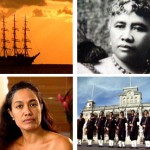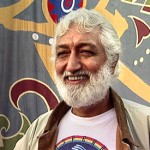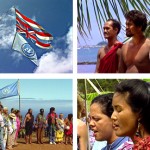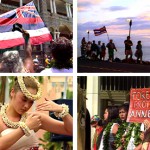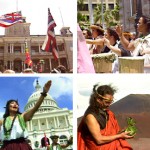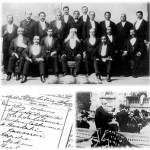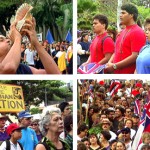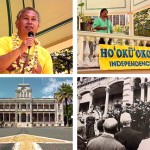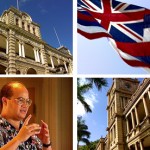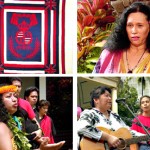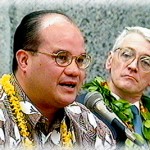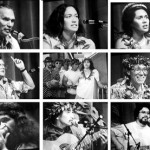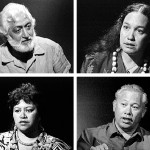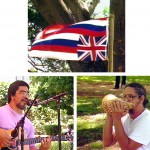Act of War – The Overthrow of the Hawaiian Nation
This hour-long documentary is a provocative look at a historical event of which few Americans are aware. In mid-January, 1893, armed troops from the U.S.S Boston landed at Honolulu in support of a treasonous coup d’état against the constitutional sovereign of the Hawaiian Kingdom, Queen Lili‘uokalani. The event was described by U.S. President Grover Cleveland as an "act of war."
Puhipau at the Yamagata International Documentary Film Festival
In October of 1993 Joan Lander and Puhipau of the production team Na Maka o ka Aina traveled to the Yamagata International Documentary Film Festival in Japan to screen their documentary, Act of War - The Overthrow of the Hawaiian Nation.
The Tribunal
Ka Ho‘okolokolonui Kānaka Maoli — Peoples' International Tribunal Hawai‘i, 1993
In August 1993, Nā Maka o ka ‘Āina spent twelve days capturing on video the proceedings Ka Ho‘okolokolonui Kānaka Maoli — Peoples' International Tribunal Hawai‘i, 1993, in which the United States and the state of Hawai‘i were put on trial for crimes against the original people of Hawai‘i, the Kānaka Maoli.
Aloha Quest – Part One
Selected segments from a historic 6-hour educational television presentation on Hawaiian sovereignty, broadcast on KFVE, Dec. 19, 1999 and streamed to the world over the Internet. Co-produced by Aloha First and Nā Maka o ka ‘Āina, Aloha Quest was hosted by Ed Kaahea, Iaukea Bright and Kaiulani Edens.
Aloha Quest – Part Two
Selected segments from a historic 6-hour educational television presentation on Hawaiian sovereignty, broadcast on KFVE, Dec. 19, 1999 and streamed to the world over the Internet. Co-produced by Aloha First and Nā Maka o ka ‘Āina, Aloha Quest was hosted by Ed Kaahea, Iaukea Bright and Kaiulani Edens.
Faces of the Nation
From the history of the Mahele and the 1893 act of war against the Hawaiian Kingdom to the modern-day struggles for land rights, this video takes a look at one of the first native initiatives for self-governance, Ka Lāhui Hawai‘i.
We Are Who We Were
From Resistance to Affirmation
On August 12, 1898, during ceremonies at ‘Iolani Palace, two figures stood on a platform before an international gathering. Sanford B. Dole and U.S. Minister Harold Sewall exchanged treaty ratifications annexing the Hawaiian Islands to the United States. Or so it appeared. But was it really a treaty of annexation? And did Hawai‘i really become a territory of the United States?
Scenes from the Centennial
During four days in January 1993, thousands observed the centennial of the 1893 act of war against the Hawaiian Kingdom. ‘Iolani Palace, Ali‘iōlani Hale and the Queen's statue were the sites for the commemoration, which included a historic march, speeches, music and presentation of ho‘okupu (offerings).
アクト・オヴ・ウォー ハワイ王国の転覆 (日本語字幕付き)
ハワイ王国の転覆という歴史上の事件を、刺激的な観点から捉えた1時間のドキュメンタリー作品。1893年1月半ば、ハワイ王国を統治するリリウオカラニ女王への反逆クーデターを支持するため、米戦艦ボストンからの武装兵士がホノルルに上陸。この事件は、クリーブランド大統領によって「アクト・オヴ・ウォー」、すなわち「戦争」と呼ばれました。
July 4th at the Palace
Poka Laenui of the Institute for the Advancement of Hawaiian Affairs relates the history of the Bayonet Constitution, the 1893 act of war against the Hawaiian Kingdom, and the formation of the self-proclaimed Republic of Hawai‘i on July 4, 1894.
Hawaiian Kingdom Law
In this five-hour series, David Keanu Sai gives a comprehensive legal history of the Hawaiian Kingdom, including the Declaration of Rights by King Kamehameha III, the formation of a constitutional monarchy, the 1850 Treaty of Friendship, Commerce and Navigation with the United States, the 1893 act of war against the Hawaiian Kingdom, the 1898 purported annexation to the U.S. and the internal U.S. legislation that supposedly made Hawai‘i a state of the union.
Hui Na‘auao – A community education project
In 1992, a year before the centennial observance of the 1893 armed invasion of Hawai‘i, a coalition of over forty Hawaiian organizations got together to educate themselves and the public on the historical basis for recognition of the Hawaiian Kingdom.
Human Rights and the Hawaiian Kingdom
Representatives of the Hawaiian Kingdom, Ka Lāhui Hawai‘i and indigenous Alaskan and Lakota Sioux peoples, along with an international law expert, discuss human rights, land titles and the legal case for recognition of the Hawaiian Kingdom.
Ho‘okū‘oko‘a 1985
Ho‘okū‘oko‘a is a Hawaiian term meaning to cause to stand independently, or to bring about independence. It was the name chosen for a historic gathering of speakers on Hawaiian sovereignty held at the Kamehameha Schools, November 30, 1985.
Hui Na‘auao – Eleven Concepts of Sovereignty
In January 1993, Puhipau of Nā Maka o ka ‘Āina invited representatives of the Hawaiian sovereignty movement to give their visions for self determination in a series of one-on-one, fifteen-minute interviews.
Ka Lā Ho‘iho‘i Ea
This July 31, 1986, gathering at Thomas Square in Honolulu was the first of a series of annual ceremonies held every year since then to re-establish the celebration of Ka Lā Ho‘iho‘i Ea (Restoration Day).

